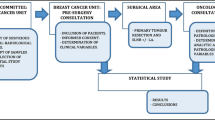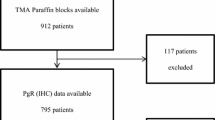Abstract
Purpose: To investigate the possible correlation between expression of HER2 and vascular endothelial growth factor (VEGF), and to determine the predictive value of these factors in patients receiving adjuvant endocrine therapy including the group with a breast cancer (BC) positive for both oestrogen receptor (ER) and progesterone receptor (PgR). Material and methods: By enzyme immuno-sorbent assays (ELISA) tumour levels of HER2 and VEGF proteins were determined in 679 consecutive primary BC patients, median age 63 years, median follow-up time 92 months. A total of 404 patients received adjuvant endocrine therapy, mainly tamoxifen, out of them 295 had an ER and PgR positive BC. In 160 patients, HER2 status was also determined by immunohistochemistry (IHC) using the monoclonal antibody CB11. Results: Overexpression of HER2 by IHC was found in 15% of the patients. Overexpression of HER2 by ELISA correlated with HER2 by IHC (P < 0.001) and a higher VEGF expression (P = 0.004). Patients receiving adjuvant endocrine therapy with high VEGF (RFS P = 0.0087, BCCS P = 0.0012) or over-expressing HER2 (RFS P = 0.0116, BCCS P = 0.0036) had significantly shorter survival. Factors retaining statistical significance in multivariate analyses for recurrence-free survival (RFS) were nodal status (P < 0.001), tumour size (P = 0.005) and VEGF (P = 0.032) and for breast cancer corrected survival (BCCS) nodal status (P < 0.001), tumour size (P = 0.001), ER status (P = 0.022), and VEGF (P = 0.016). Both factors were significantly correlated with survival in the group with a BC positive for both ER and PgR; VEGF (RFS P = 0.0177, BCCS P = 0.0321) and HER2 (RFS P = 0.0143, BCCS P = 0.0311). In multivariate analyses, nodal status (P < 0.001) and VEGF (P = 0.021) were independent factors for RFS. Nodal status (P < 0.001) and tumour size (P = 0.016) retained independent factors for BCCS. Combined analysis identified a high-risk group (HER2 positive and high VEGF) with significantly reduced survival. Conclusion: The results from this retrospective analysis suggest that overexpression of HER2 and higher VEGF expression may add information on patient’s outcome after adjuvant endocrine therapy in ER and PgR positive BC.



Similar content being viewed by others
References
Early Breast Cancer Trialists, Early Breast Cancer Trialists Collaborative Group. Systemic treatment of early breast cancer by hormonal, cytotoxic, or immune therapy. Lancet. 1992;399:1–15.
Dowsett M. Overexpression of HER-2 as a resistance mechanism to hormonal therapy for breast cancer. Endocr Relat Cancer. 2001;8:191–4.
Honig SF. Treatment of metastatic disease: hormonal therapy and chemotherapy. In: Harris JR, Lippman ME, Morrow M, Hellman S, editors. Diseases of the breast. Philadelphia, PA: Lippincott-Raven; 1996. p. 669–734.
Goldhirsh A, Colleoni M, Gelber R. Endocrin therapy in breast cancer. Ann Oncol. 2002;13(Suppl 4):61–8.
Schiff R, Massarweh S, Shou J, Osborn K. Breast cancer endocrine resistance: how growth factor signaling and estrogen receptor coregulators modulate response. Clin Cancer Res. 2003;9:447–54. Suppl.
Johnston SRD, Andersson E, Dowsett M, Howell A. Hormonal resistance in breast cancer. In: Oettel M, Schillinger E, editors. Handbook of experimental pharmacology: estrogens and antiestrogens II. Berlin: Springer-Verlag; 1999. p. 205–11.
Johnston SRD, Saccanti-Jotti G, Smith IE, Newby J, Dowsett M. Change in oestrogen receptor expression and function in tamoxifen-resistant breast cancer. Endocr Relat Cancer. 1995;2:105–10.
Aronica SM, Katzenellenbogen BS. Stimulation of estrogen receptor-mediated transcription and alteration in the phosphorylation state of the rat uterine estrogen receptor by estrogen, cyclin adenosine monophosphate, and insulin-like growth factor-I. Mol Endocrinol. 1993;7:743–52.
Pietras RJ, Arboleda J, Reese DM, Wongvipat N, Pegram MD, Parker MG, et al. HER-2 tyrosine kinase pathway targets estrogen receptor and promotes hormone-independent growth in human breast cancer cells. Oncogene. 1995;10:2435–46.
Bunone G, Briand PA, Miksicek RJ, Picard D. Activation of the unliganded estrogen receptor by EGF involves the MAP kinase pathway and direct phosphorylation. EMBO J. 1996;15:2174–83.
De Placido S, Carlomagno C, De Laurentis M, Bianco AR. c-erbB-2 expression predicts tamoxifen efficacy in breast cancer patients. Breast Cancer Res Treat. 1998;52:55–64.
Linderholm B, Grankvist K, Wilking N, Johansson M, Tavelin B, Henriksson R. Correlation of Vascular Endothelial Growth Factor (VEGF) and survival, metastasis sites and responsiveness to adjuvant systemic treatment in primary node-positive breast carcinoma. J Clin Oncol. 2000;18:1423–31.
Linderholm B, Andersson J, Lindh B, Tavelin B, Erlanson M, Beckman L, et al. Overexpression of c-erbB-2 is related with higher expression of vascular endothelial growth factor (VEGF) and of prognostic value in primary node-positive breast cancer following adjuvant systemic therapy. Eur J Cancer. 2004;40(1):33–42.
Rutqvist LE. Zoladex and tamoxifen as adjuvant therapy in premenopausal breast cancer: a randomised trial by the Cancer Research Campaign (C.R.C) Breast Cancer Trial Group, the Stockholm Breast Cancer Study Group, the South-East Sweden Breast Cancer Group & the Gruppo Interdisciplinare Valutazione Interventi di Oncologia (G.I.V.I.O.). Proc Am Soc Clin Oncol. 1999;18:67a, (abstr 251).
Coradini D, Biganzoli E, Pellizzaro C, Veneroni C, Oriana S, Ambrogini F, et al. Vascular endothelial growth factor in node-positive breast cancer patients treated with adjuvant tamoxifen. Br J Cancer. 2003;89:268–70.
Ruhola JK, Valve EM, Karkkainen MJ, Joukov V, Alitalo K, Harkonen PL. Vascular endothelial growth factors are differentially expressed by steroid hormones and antiestrogens in breast cancer cells. Mol Cell Endocrinol. 1999;149:29–40.
Hyder SM, Murthy L, Stancel GM. Progestin regulation of vascular endothelial growth factor in human breast cancer cells. Cancer Res. 1998;58:392–5.
Hyder SM, Stancel GM. Regulation of vascular endothelial growth factor by sex steroids. Histol Histopathol. 2000;15:325–34.
Hyder SM, Nawas Z, Chiapetta C, Stancel GM. Identification of functional estrogen receptor response elements in the gene coding for the potent angiogenic factor vascular endothelial growth factor. Cancer Res. 2000;60:3183–90.
Hyder SM, Chiapetta C, Murthy L, Stancel GM. Selective inhibition of estrogen-regulated gene expression in vivo by the pure antiestrogen ICI 182, 780. Cancer Res. 1997;57:2547–9.
Miralem T, Steinberg R, Price D, Avraham H. VEGF(165) requires extra-cellular matrix components to induce mitogenic effects and migratory response in breast cancer cells. Oncogene. 2001;20:5511–24.
Poon RT-P, Fan S-T, Wong J. Clinical implications of circulating angiogenic factors in cancer patients. J Clin Oncol. 2001;19:1207–25.
Ryden L, Linderholm B, Emdin S, Jönsson P-E, Landberg G. Tumor specific VEGF-A and VEGFR2/KDR protein are co-expressed in human breast cancer. Breast Cancer Res Treat. 2003;82(3):147–54.
Kato S, Endoh H, Masuhiro Y, Uchiyama S, Sasaki H, Masushige S, et al. Activation of the estrogen receptor through phosphorylation by mitogen-activated protein kinase. Science. 270:1491–4.
Lee AV, Weng CN, Jackson JG, Yee D. Activation of estrogen receptor-mediated gene transcription by IGF-I in human breast cancer cells. J Endocrinol. 1997;152:39–47.
Goldman CK, Kim J, Wong WL, King V, Brock T, Gillespie GY. Epidermal growth factor stimulates vascular endothelial growth factor production by human malignant glioma cells: a model of glioblastoma multiforme pathophysiology. Mol Biol Cell. 1993;4:121–33.
Schreiber AB, Winkler ME, Derynck R. Transforming growth factor-α: a more potent angiogenic mediator than epidermal growth factor. Science (Washington DC). 1986;232:1250–3.
Dowsett M, et al. HER-2 amplification impedes the antiproliferative effects of hormone therapy in estrogen receptor-positive primary breast cancer. Cancer Res. 2001;61(23):8452–8.
Ellis MJ, Coop A, Singh B, et al. Letrozole is more effective neoadjuvant endocrine therapy than tamoxifen for ErbB-1 and/or Erb-B2-positive, estrogen receptor positive primary breast cancer: evidence from a randomized trial. J Clin Oncol. 2001;19:3808–16.
Love RR, Duc NB, Havighurst TC, Mohsin SK, Zhang Q, DeMets D, et al. HER-2/neu overexpression and response to oophorectomy plus tamoxifen adjuvant therapy in estrogen receptor-positive premenopausal women with operable breast cancer. J Clin Oncol. 2003;21(3):453–7.
Rasmussen BB, Pegan MM, Lykkesfeldt AE, Dell′Orto P, Del Curto B, Henriksen KL, et al. Adjuvant letrozole versus tamoxifen according to centrally-assessed ERBB2 status for postmenopausal women with endocrine-responsive early breast cancer: supplementary results from the BIG 1–98 randomised trial. Lancet Oncol. 2008;9:23–8.
Dowsett M, Allred C, Knox J, Quinn E, Salter J, Wale C, et al. Relationship between quantitative estrogen and progesterone receptor expression and human epidermal growth factor receptor 2 (HER2) status with recurrence in the arimidex tamoxifen, alone and in combination trial. J Clin Oncol. 2008;7:1059–65.
Acknowledgements
This study was supported by grants from the Swedish Cancer Society, the Swedish Society of Medicine, the King Gustav V Research Foundation, the Karolinska University Hospital Research Foundation, Stockholm, and Henning and Ida Perssons Research Foundation, Malmö, Sweden.
Author information
Authors and Affiliations
Corresponding author
Rights and permissions
About this article
Cite this article
Linderholm, B., Bergqvist, J., Hellborg, H. et al. Shorter survival-times following adjuvant endocrine therapy in oestrogen- and progesterone-receptor positive breast cancer overexpressing HER2 and/or with an increased expression of vascular endothelial growth factor. Med Oncol 26, 480–490 (2009). https://doi.org/10.1007/s12032-008-9157-9
Received:
Accepted:
Published:
Issue Date:
DOI: https://doi.org/10.1007/s12032-008-9157-9




